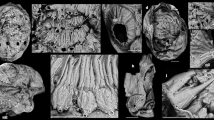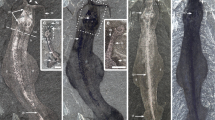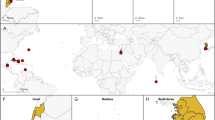Abstract
THE Chengjiang fossil Lagerstätte is one of the earliest and most important palaeontological sites from the Phanerozoic era1,2, about 530 million years ago3. It yields extremely abundant and remarkably preserved soft-bodied fossils and shells with soft parts of various kinds, including bradoriids4–6, trilobites7,8, crustaceans9, brachiopods, worms, sponges, algae and many unknown forms10–13. One of these fossils is Yunnanozoon14, which we reinterpret here as the earliest known hemichordate. Possessing half of the characteristic chordate features and providing an anatomical link between invertebrates and chordates15, Hemichor-data is a minor but important phylum in evolutionary biology. Hemichordates comprise two main groups: the enteropneusts, or 'acorn worms', and the pterobranchs. Apart from the presumable inclusion of graptolites in pterobranchs16–19, there are very few hemichordate fossils2,17,20. Although Yunnanozoon is superficially similar to the chordates21, its typical tripartite body plan is broadly consistent with that of living balanoglossid hemichor-dates (enteropneusts).
This is a preview of subscription content, access via your institution
Access options
Subscribe to this journal
Receive 51 print issues and online access
$199.00 per year
only $3.90 per issue
Buy this article
- Purchase on Springer Link
- Instant access to full article PDF
Prices may be subject to local taxes which are calculated during checkout
Similar content being viewed by others
References
Conway Morris, S. Nature 361, 219–225 (1993).
Chen, J., Ramsköld, L. & Zhou, G. Science 264, 1034–1068 (1994).
Bowring, S. A. et al. Science 261, 1293–1298 (1993).
Huo, S. & Shu, D. Cambrian Bradoriida of South China (Northwest Univ. Press, Xian, 1985).
Shu, D. Cambrian and Lower Ordovician Bradoriids from Zhejiang, Hunan and Shaanxi (Northwest Univ. Press, Xian, 1990).
Shu, D. Cour. Forsch-Inst Senck. 123, 315–330 (1990).
Zhang, W. Acta palaeont. sin. 26, 223–235 (1987).
Shu, D., Geyer, G., Chen, L. & Zhang, X. Beringeria (suppl.) 2, 203–241.
Shu, D., Zhang, X. & Geyer, G. Alcheringa 19, 333–342 (1996).
Hou, X. Acta palaeont. sin. 26, 286–298 (1987).
Ramsköld, L. Lethaia 25, 443–460 (1992).
Shu, D. et al. NW Univ. (suppl.) 22, 31–38 (1992).
Shu, D. & Chen, L. J. SE-Asian Sci. 9, 289–299 (1994).
Hou, X., Ramsköld, L. & Bergström, J. Zool. Scripta 20, 395–411 (1991).
Barnes, R. S. K., Calow, P., Olive, P. J. W. & Golding, D. W. The Invertebrates—a New Synthesis (Blackwell Scientific, Oxford, 1988).
Kozlowski, R. Palaeont. pol. 3, 1–235 (1949).
Broadman, R., Cheethan, A. & Rowell, A. Fossil Invertebrates (Blackwell Scientific, Oxford, 1987).
Bengtson, S. & Urbanek, A. Lethaia 19, 293–308 (1986).
Durman, P. N. & Sennikov, N. V. Palaeontology 36, 283–296 (1993).
Arduini, P., Pinna, G. & Teruzzi, G. Atti Soc. ital. Sci. nat. Museo civ. Storia nat. Milano 122, 104–108 (1981).
Chen, J., Dzik, J., Edgecombe, G. D., Ramsköld, L. & Zhou, G. Nature 377, 720–722 (1995).
Romer, A. S. The Vertebrate Body, (W. B. Saunders, Philadelphia, 1964).
Barnes, R. D. Invertebrate Zoology, 1018–1028 (Saunders College, Philadelphia, 1980).
Jefferies, R. P. S. The Ancestry of the Vertebrates, (British Museum, London, 1986).
Briggs, D. E. G. & Kear, A. J. Lethaia 26, 275–287 (1994).
Conway Morris, S. (ed.) Atlas for the Burgess Shale (Palaeontological Association, London, 1982).
Briggs, D. E. G., Erwin, D. H. & Collier, F. J. The Fossils of the Burgess Shale, 197–198 (Smithsonian Institution Press, Washington, DC, 1994).
Author information
Authors and Affiliations
Rights and permissions
About this article
Cite this article
Shu, D., Zhang, X. & Chen, L. Reinterpretation of Yunnanozoon as the earliest known hemichordate. Nature 380, 428–430 (1996). https://doi.org/10.1038/380428a0
Received:
Accepted:
Issue Date:
DOI: https://doi.org/10.1038/380428a0
This article is cited by
-
The Chengjiang Biota inhabited a deltaic environment
Nature Communications (2022)
-
Community structure and composition of the Cambrian Chengjiang biota
Science China Earth Sciences (2010)
-
The Evolutionary Emergence of Vertebrates From Among Their Spineless Relatives
Evolution: Education and Outreach (2009)
-
Evolutionary Origins of the Neural Crest and Neural Crest Cells
Evolutionary Biology (2008)
-
Gill rays of primitive vertebrate Yunnanozoon from Early Cambrian: a first record
Frontiers of Biology in China (2008)
Comments
By submitting a comment you agree to abide by our Terms and Community Guidelines. If you find something abusive or that does not comply with our terms or guidelines please flag it as inappropriate.



